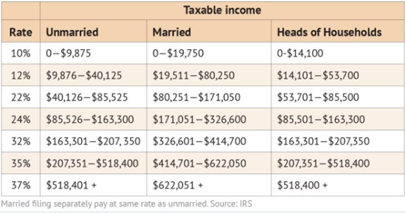Roth IRA Conversions: Pay Now, Live Tax-Free Later
Why now may be the time to convert your traditional IRA to a Roth to avoid future taxes.


There was a lot of discussion around tax increases in the run-up to the election. On one side, raising taxes on corporations and on ultra-high net worth individuals. The other side focusing on foreign taxes and tariffs. The one thing everyone can agree on is that taxes are going to go up in the future.
The United States has over $27 TRILLION in debt, which is climbing rapidly. The government has issued billions in Coronavirus stimulus packages, and unemployment hit 13% in May, the second highest rate since World War II. We also have a Social Security system that is quickly running out of money. There is a clear need for more tax dollars.
No matter where the focus (corporations, ultra-high net worth individuals or foreign countries), there is always a tax burden that falls on everyday Americans. It is fair to assume that burden will likely grow in the future. So how can you set yourself up now for what may lie ahead?
From just $107.88 $24.99 for Kiplinger Personal Finance
Become a smarter, better informed investor. Subscribe from just $107.88 $24.99, plus get up to 4 Special Issues

Sign up for Kiplinger’s Free Newsletters
Profit and prosper with the best of expert advice on investing, taxes, retirement, personal finance and more - straight to your e-mail.
Profit and prosper with the best of expert advice - straight to your e-mail.
How Do Roth IRA Conversions Work?
Roth conversions are the best way to take a little pain today to give yourself options in the future. A Roth conversion is when you take money out of a traditional IRA and transfer it directly into a Roth IRA. When you do this, the amount converted IS taxable. You pay income tax on the entire amount moved into your Roth IRA.
Once it is in the Roth IRA, the growth is tax-free. As long as you have had the account for five years and you are 59½ or older, you can take the entire amount of a Roth IRA out tax-free.
What Are the Benefits?
Tax-Free Growth
If we are under the assumption that taxes will go up in the future, it makes sense to pay taxes on some of your money now to avoid taxes at higher rates in the future. For example, according to U.S. Census Bureau, the median household income in 2019 was $65,712. The standard deduction this year for a married filing jointly household is $24,800. That leaves an adjusted income amount of $40,912. Based on 2020 tax brackets (see chart below), this places the median household in the 12% tax bracket. This bracket goes up to $80,250 worth of income.
So, there is room for nearly another $40,000 before the median household moves up to the 22% bracket. That is $40,000 of opportunity. Opportunity to convert $40,000 from traditional IRA monies to a Roth IRA. You pay 12% in federal income taxes to move this money, but the way I see it that could be a steal in the future.

Lower RMDs on Your Traditional IRAs in the Future
Required minimum distributions (RMD) are due in April the year following your 72nd birthday. An RMD is a set percentage of your traditional IRA that you must withdraw for that given year. The percentage you must take out also increases over time. One hundred percent of required minimum distributions are taxed like income, and you cannot convert RMDs. These required withdrawals may be more money than you can spend, but it doesn’t matter, they are REQUIRED. By doing Roth IRA conversions in your 50s and 60s, you are reducing the value of your traditional IRAs. Therefore, when your 70s come around, your RMD amounts will be smaller. This will minimize the taxation on your traditional IRA in the future and make tax-free dollars available in your Roth IRA for supplemental income.
The Ability to Leave a Tax-Free Estate
One of the biggest negatives to the SECURE Act is the rules on inheritances. Before the SECURE Act, beneficiaries could stretch inherited IRAs over their entire lifetime. Now, with only a few exceptions, beneficiaries have 10 years to withdraw the entire amount of inherited IRAs and inherited Roth IRAs. That means 10 years to pay the taxes on inherited IRAs.
Typically, when you’re inheriting an IRA from Mom or Dad, you are in your prime working years, making more money than you ever had. Now, when you take that money from the inherited IRA you’re paying taxes at your high, working tax rate. This can end up with Uncle Sam getting 40% of your IRA through taxes. On the flip side, inherited Roth IRAs remain tax-free for the beneficiary. Paying taxes on your IRA in your 50s and 60s can help save taxes for you in retirement AND your children after you die.
Some People Who Should Think Twice before Doing a Roth IRA Conversion
The idea of doing a Roth conversion is to have a little pain now by paying the tax to have no pain or tax-free dollars in the future. Therefore, if you are a high-income earner now, a Roth conversion may not make sense for you. This is the case for many who will be in a lower tax bracket in the future. If you were to make a large conversion now, you would pay taxes at your high rate to not pay taxes at your lower future retirement rate. In this scenario, it wouldn’t make sense to utilize Roth conversions. (For more, please see 6 Reasons You Should NOT Do a Roth Conversion.)
The Bottom Line on Roth IRA Conversions
Nobody enjoys paying taxes. However, it may be in your best interest to pay more in taxes now to set yourself up to have tax-free income in the future. Giving Uncle Sam nickels and dimes today can keep dollar bills for you and your family in the future.
Profit and prosper with the best of Kiplinger's advice on investing, taxes, retirement, personal finance and much more. Delivered daily. Enter your email in the box and click Sign Me Up.

Phil Huff is the vice president and investment adviser representative licensed with Independence Wealth Advisors LLC, a registered investment adviser. As a former offensive lineman for Kent State University, he excels at protecting people. His focus is on optimizing his clients’ life savings throughout retirement by taking a holistic approach to planning, developing and implementing personalized investment plans, retirement income planning and risk management.
-
 Your Guide to Buying Art Online
Your Guide to Buying Art OnlineFrom virtual galleries to social media platforms, the internet offers plenty of places to shop for paintings, sculptures and other artwork without breaking the bank.
-
 Samsung Galaxy S25 Ultra for $4.99 a Month: A Closer Look at Verizon’s Deal
Samsung Galaxy S25 Ultra for $4.99 a Month: A Closer Look at Verizon’s DealVerizon’s aggressive pricing makes Samsung’s top-tier phone tempting, but the real cost depends on your plan and how long you stay.
-
 I'm 59 with $1.7 million saved and lost my job. Should I retire?
I'm 59 with $1.7 million saved and lost my job. Should I retire?We asked professional wealth planners for advice.
-
 A Wealth Adviser Explains: 4 Times I'd Give the Green Light for a Roth Conversion (and 4 Times I'd Say It's a No-Go)
A Wealth Adviser Explains: 4 Times I'd Give the Green Light for a Roth Conversion (and 4 Times I'd Say It's a No-Go)Roth conversions should never be done on a whim — they're a product of careful timing and long-term tax considerations. So how can you tell whether to go ahead?
-
 A 4-Step Anxiety-Reducing Retirement Road Map, From a Financial Adviser
A 4-Step Anxiety-Reducing Retirement Road Map, From a Financial AdviserThis helpful process covers everything from assessing your current finances and risks to implementing and managing your personalized retirement income plan.
-
 The $183,000 RMD Shock: Why Roth Conversions in Your 70s Can Be Risky
The $183,000 RMD Shock: Why Roth Conversions in Your 70s Can Be RiskyConverting retirement funds to a Roth is a smart strategy for many, but the older you are, the less time you have to recover the tax bite from the conversion.
-
 A Financial Pro Breaks Retirement Planning Into 5 Manageable Pieces
A Financial Pro Breaks Retirement Planning Into 5 Manageable PiecesThis retirement plan focuses on five key areas — income generation, tax management, asset withdrawals, planning for big expenses and health care, and legacy.
-
 4 Financial To-Dos to Finish 2025 Strong and Start 2026 on Solid Ground
4 Financial To-Dos to Finish 2025 Strong and Start 2026 on Solid GroundDon't overlook these important year-end check-ins. Missed opportunities and avoidable mistakes could end up costing you if you're not paying attention.
-
 Are You Putting Yourself Last? The Cost Could Be Your Retirement Security
Are You Putting Yourself Last? The Cost Could Be Your Retirement SecurityIf you're part of the sandwich generation, it's critical that you don't let the needs of your aging parents come at the expense of your future.
-
 I'm an Insurance Pro: It's Time to Prepare for Natural Disasters Like They Could Happen to You
I'm an Insurance Pro: It's Time to Prepare for Natural Disasters Like They Could Happen to YouYou can no longer have the mindset that "that won't happen here." Because it absolutely could. As we head into 2026, consider making a disaster plan.
-
 The Future of Philanthropy Is Female: How Women Will Lead a New Era in Charitable Giving
The Future of Philanthropy Is Female: How Women Will Lead a New Era in Charitable GivingWomen will soon be in charge of trillions in charitable capital, through divorce, inheritance and their own investments. Here's how to use your share for good.